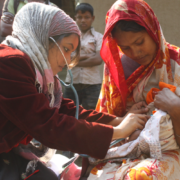Why Integrate SBCC into Service Delivery? Discuss.
Several years ago, I found myself in a newly renovated adolescent-friendly clinic. The clinic was bustling with youth – youth who were reportedly very satisfied with their services. Service statistics told a similar story: condom sales had risen and pregnancy rates had declined.
What accounted for this success? The incorporation of social and behavior change communication (SBCC) principles.
Clinic staff had used SBCC to change local norms around health-seeking behavior and acceptability of products and services. They had generated demand and improved interactions at the clinic through quality branded services. Community and peer-level activities supported desirable behaviors and created forums for open discussion.
Using SBCC before, during and after services can enhance the impact of a service delivery program. It can help create an enabling environment, get clients to services, improve the client-provider interaction and support behavioral maintenance. Often however, those benefits are missed due to lack of clarity around what SBCC is and how it can be used in a service delivery context. Coordinating efforts between SBCC and service delivery projects can also be difficult, with confusion around where the role of SBCC partners ends and that of service delivery partners begins.
To reap the benefits SBCC can offer, we must determine how we can integrate SBCC more effectively into service delivery programs and improve coordination between SBCC and service delivery partners. Join Jane Wickstrom, Chelachew Tiruneh, Shahira Hussein and me as we facilitate a discussion on how we can improve those linkages between SBCC and service delivery, August 17-18 on Spingboard for Health Communication Professionals.
 You must be a registered Springboard member to participate. To register:
You must be a registered Springboard member to participate. To register:
- Fill out the online registration form on Springboard.
- Activate your registration via the email you receive after filling out the registration form.
- Navigate to the conversation here.
The discussion seeks perspectives from service delivery implementers as well as SBCC practitioners to inform USAID’s thinking around the linkages between service delivery and SBCC.
Don’t miss your opportunity to help strengthening the understanding of the concept/strategy of incorporating SBCC and service delivery and how this integration is approached.
More about the facilitators:
 Heather Hancock, MPH is a health communication specialist with expertise in reproductive health/family planning and capacity strengthening. She has been responsible for designing and implementing SBCC programs across Asia, the Middle East, and Latin America for over ten years. Most recently she has provided technical assistance to HC3’s capacity strengthening team to develop tools and resources to enhance health communication capacity. She currently leads HC3’s service communication and provider-related activities. Prior to joining Johns Hopkins Center for Communication Programs, Ms. Hancock led health education programs in Latin America.
Heather Hancock, MPH is a health communication specialist with expertise in reproductive health/family planning and capacity strengthening. She has been responsible for designing and implementing SBCC programs across Asia, the Middle East, and Latin America for over ten years. Most recently she has provided technical assistance to HC3’s capacity strengthening team to develop tools and resources to enhance health communication capacity. She currently leads HC3’s service communication and provider-related activities. Prior to joining Johns Hopkins Center for Communication Programs, Ms. Hancock led health education programs in Latin America.
 Shahira Hussein, MS, MBBCh joined USAID/Egypt in 2011 as a Senior Project Management Specialist in the Office ofHealth and Population. She provides technical leadership for design and implementation of activities in the areas of family planning, reproductive health, maternal and child health, and nutrition. Shahira is the health team’s youth, gender, and SBCC technical point of contact. Prior to joining USAID, Shahira worked for thirteen years with a number of international organizations on implementing USAID-funded health projects.
Shahira Hussein, MS, MBBCh joined USAID/Egypt in 2011 as a Senior Project Management Specialist in the Office ofHealth and Population. She provides technical leadership for design and implementation of activities in the areas of family planning, reproductive health, maternal and child health, and nutrition. Shahira is the health team’s youth, gender, and SBCC technical point of contact. Prior to joining USAID, Shahira worked for thirteen years with a number of international organizations on implementing USAID-funded health projects.
 Jane Wickstrom, MA is EngenderHealth’s Project Director for the Expand Family Planning (FP) Project and Senior Technical Advisor for FP. For over 30 years, Ms. Wickstrom has provided technical assistance, innovative program design and evaluation services to Ministries of Health, district health officials, NGOs and the private sector to improve access and use of family planning and reproductive health services in over 20 countries in Africa and Asia. Most recently, she has focused her efforts on implementing comprehensive programming to increase access to the highly effective, yet under-utilized, long-acting reversible and permanent methods of contraception. Another technical interest of hers include: scaling-up quality improvement initiatives to ensure contraceptive security at the “last mile”; using data and advocacy to spur action for FP at district levels; support for mobile outreach services to reach under-served populations; and, reaching youth with FP information and services using innovative service and social/behavior change approaches. Ms. Wickstrom is the author of several peer-reviewed journals, technical reports, briefs, and project design documents.
Jane Wickstrom, MA is EngenderHealth’s Project Director for the Expand Family Planning (FP) Project and Senior Technical Advisor for FP. For over 30 years, Ms. Wickstrom has provided technical assistance, innovative program design and evaluation services to Ministries of Health, district health officials, NGOs and the private sector to improve access and use of family planning and reproductive health services in over 20 countries in Africa and Asia. Most recently, she has focused her efforts on implementing comprehensive programming to increase access to the highly effective, yet under-utilized, long-acting reversible and permanent methods of contraception. Another technical interest of hers include: scaling-up quality improvement initiatives to ensure contraceptive security at the “last mile”; using data and advocacy to spur action for FP at district levels; support for mobile outreach services to reach under-served populations; and, reaching youth with FP information and services using innovative service and social/behavior change approaches. Ms. Wickstrom is the author of several peer-reviewed journals, technical reports, briefs, and project design documents.
 Chalachew Tiruneh, MPH, CIPM is a Public Health and Projects Management practitioner with over ten years’ experience. He is currently in Washington DC as a Family Planning and Reproductive Health Program Specialist Fellow in PRH office. He has experience on range of public health issues including reproductive health, HIV, family planning, nutrition, malaria and behavior change communication. He is working on HIV, SBCC and Youth Programs in USAID since 2012. He has been an activity manager and an AOR for four programs. Before Joining USAID, he worked for Save the Children International. He is a certified project manager, public health practitioner with an MPH and currently studying his MBA.
Chalachew Tiruneh, MPH, CIPM is a Public Health and Projects Management practitioner with over ten years’ experience. He is currently in Washington DC as a Family Planning and Reproductive Health Program Specialist Fellow in PRH office. He has experience on range of public health issues including reproductive health, HIV, family planning, nutrition, malaria and behavior change communication. He is working on HIV, SBCC and Youth Programs in USAID since 2012. He has been an activity manager and an AOR for four programs. Before Joining USAID, he worked for Save the Children International. He is a certified project manager, public health practitioner with an MPH and currently studying his MBA.








Leave a Reply
Want to join the discussion?Feel free to contribute!